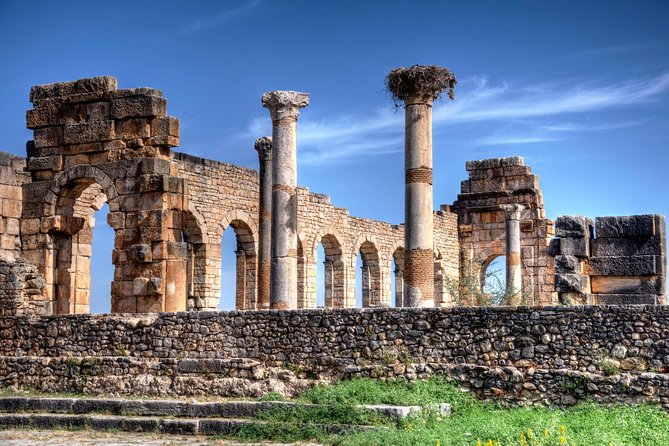
Visible from the nearby holy city of Moulay Idriss Zerhoune, and from the highest points of the valley, Volubilis is the best known and best-preserved archaeological site in Morocco. This ancient Roman city, located between the imperial cities of Fes and Meknes in a fertile plain, once stretched over 40 hectares.
History of Volubilis, Morocco:
The history of Volubilis perfectly represents the many cultural influences of Morocco. The city bears the marks of different civilizations.
Volubilis was founded in the 3rd century BC at a time when the area was part of Mauritania, which was then the territory of the Berbers. It was its capital and administrative center and also one of the most remote cities of the Roman Empire, located in the southwest region.
The city grew rapidly when it was controlled by the Romans. The Romans transformed it into a typical city, complete with palaces to house Roman officials, a historic center, a triumphal arch, and temples dedicated to the Roman gods. Christianity was the practiced religion and Latin was the language spoken by the Greeks, Jews, and Syrians who inhabited the city.
Volubilis really began to prosper in the second and third centuries. At its peak, the city had between 10,000 and 20,000 inhabitants according to historians, and lived mainly from the olive oil trade. The plains near Volubilis are still covered with olive trees!
The Romans left Volubilis towards the end of the 3rd century AD. It was later inhabited by a Christian community. Later, with the arrival of Islam in Morocco, the city became Muslim and was inhabited until the 11th century.
Volubilis was not abandoned altogether, not even when the capital was transferred to Tangier in the third century and not even when Fes was founded in the eighth century. This was until the 18th century when a great earthquake seriously damaged it.
In its present state, Volubilis remains an important Roman site and well preserved. The nearest city is Moulay Idriss, named after the great-grandson of the prophet Muhammad. The site became famous abroad when Martin Scorsese chose it as a distinctive setting for his film “The Last Temptation of Christ”.
How does Volubilis look like today?
The Roman ruins of Volubilis are very interesting to visit because they are particularly well preserved for a 2000-year-old city! Volubilis is now a UNESCO world heritage site.
The site rests on a plain at an elevation of 396m. On both sides, it is bordered by two different rivers: Fertassa and Oued Khomane. Visitors here find fertile land and beautiful gardens, in stark contrast to some of the arid landscapes of the Moroccan desert in the south.
The town once had many stately homes, dozens of bakeries, and over 100 oil mills. After the earthquake that damaged the uninhabited city of Volubilis, numerous objects and statues were looted or displayed in museums. Blocks of stone or marble were used for construction in the surrounding area, including for Meknes.
However, the site of Volubilis remains worthy of interest.
Arch of Caracalla:
One of the symbols of Volubilis is the Arch of Caracalla. This rather well-preserved arch measures 8 meters in height and more than 20 meters in length. Its initial height was 14 meters! There is also the Porta Tingis, the Decumanus Maximus, the Basilica, and the Capitol.
But the real attraction of Volubilis is the beautiful tile mosaics that cover the floors. The images of Bacchus on his chariot and the depiction of the myth of Orpheus are almost perfectly intact and still in their original places, as are the Bath of Diana, the Labors of Hercules, the Nymphs at the Bath, Dionysus, and the Four Seasons. In all, there are about 30 mosaics on the site, some fenced off for preservation and protection from visitor wear and tear.
The site is quite extensive; it takes at least 2 hours to visit Volubilis.
Visit Moulay Idriss Zerhoun:
When you visit Volubilis, you can also stop for a short visit to the nearby town of Moulay Idriss Zerhoun, of about 10,000 inhabitants.
Moulay Idriss Zerhoun is an important spiritual city in Morocco because it houses the mausoleum of Moulay Idriss, founder of the city and the Idrissid dynasty. Moulay Idriss is also the founder of the city of Fes.
Access to the city of Moulay Idriss has long been forbidden to non-Muslims. Only since 1916 also the members of other religions can visit this city, except the mosques.
The narrow streets typical of the medinas of other Moroccan cities offer beautiful views for photographs. From here you can see the ancient city of Volubilis and the fertile plain that extends below the city!
Practical information to visit Volubilis, Morocco:
- Admission to the site costs 70 DH for adults and 30 DH for children under 12.
- If you visit the site in the summer, it is best to avoid the hottest hours, as there are no places to shelter from the sun.
- The visit to Volubilis takes approximately a couple of hours.
- You can find a refreshment point before the entrance and nearby bathrooms.
- Parking is free (in front of the main entrance of the site).
- Access to the site is also possible with strollers.
How to get there?
The ruins of the Roman city of Volubilis are located near the city of Moulay Idriss Zerhoun, 30 kilometers north of Meknes. You can visit it using a petite taxi or the Grand Taxi, also, you can book a guided tour with Travelling In Morocco.




